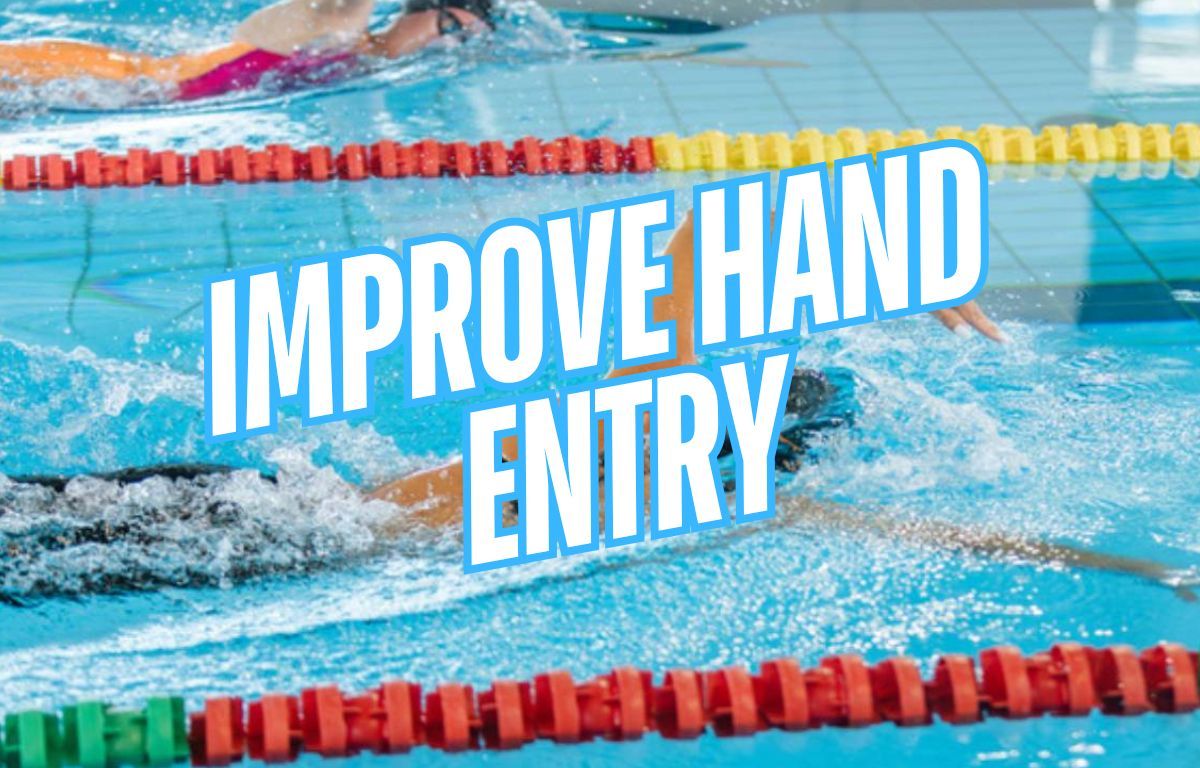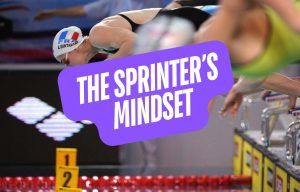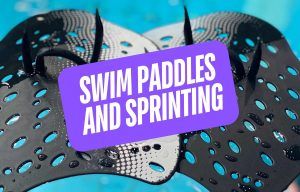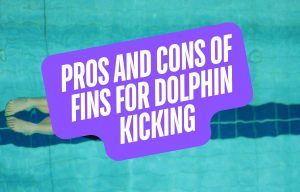Dive into a perfect freestyle hand entry with our guide to faster, more powerful freestyle swimming.
Every swimmer wants to swim faster freestyle when they step out onto the pool deck.
But swimming with perfect freestyle technique and mastering all of the critical details of efficient swimming can leave you feeling like you are swimming in circles.
Especially when improving your freestyle hand entry, which can be tricky.
This phase of the stroke is where your hand goes into the water and begins the pull. Problems start when we use incorrect hip roll, low elbow position in the recovery, insufficient shoulder roll, and poor breathing mechanics.
In this article on swimming with perfect freestyle hand entry, we will cover everything you need to know to swim with fast, clean technique in the pool.
Including:
- How to lead the hand for a fast and clean entry with every stroke.
- Common technique issues that cause poor hand entry.
- Cues for a more powerful and efficient hand entry.
- Swim gear to use for improving hand entry.
- Freestyle drills for perfect hand entry.
And much more.
Let’s dive right in.
How to Perfect Freestyle Hand Entry
In this guide, we will cover the following essentials for excellent freestyle hand entry:
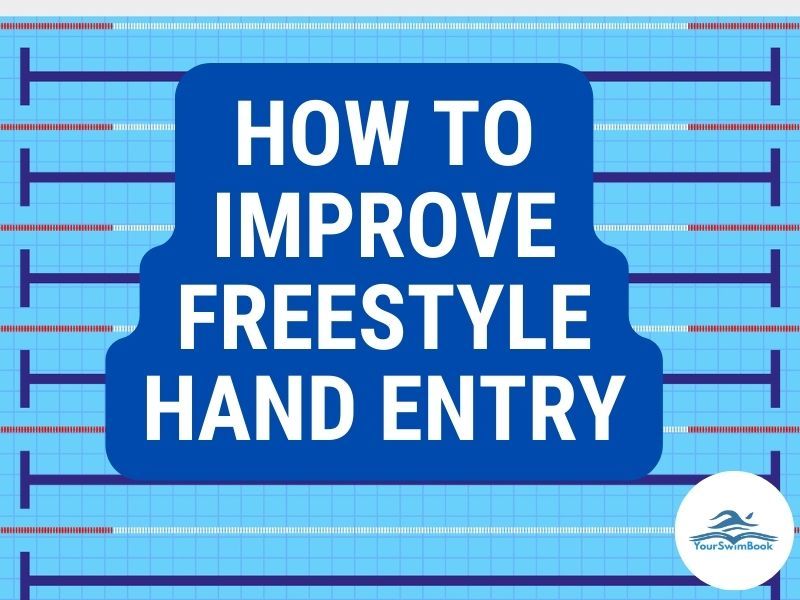
- Lead with the middle finger.
- Fixing the dropped elbow during the recovery.
- “Reach for the wall” with each stroke.
- Attack with the hand
- Use a swim snorkel to improve breathing mechanics.
- Improve core strength.
- Use drills to improve hand entry technique.
- Video feedback.
Next, we will look at each tip in more detail.
Later, we will also look at how to put it all together in the pool with some swim sets to improve hand entry.
1. Lead with the middle finger.
When the hand enters the water, the tip of your middle finger should be the first thing that gets wet.
Not your thumb. Not your index finger. And definitely not the outside of the hand.
In the image below, the greatest swimmer of all time, Michael Phelps, exhibits how his hand leads with the middle finger, pointed downwards, ready to scoop a heaping ton of pool water.
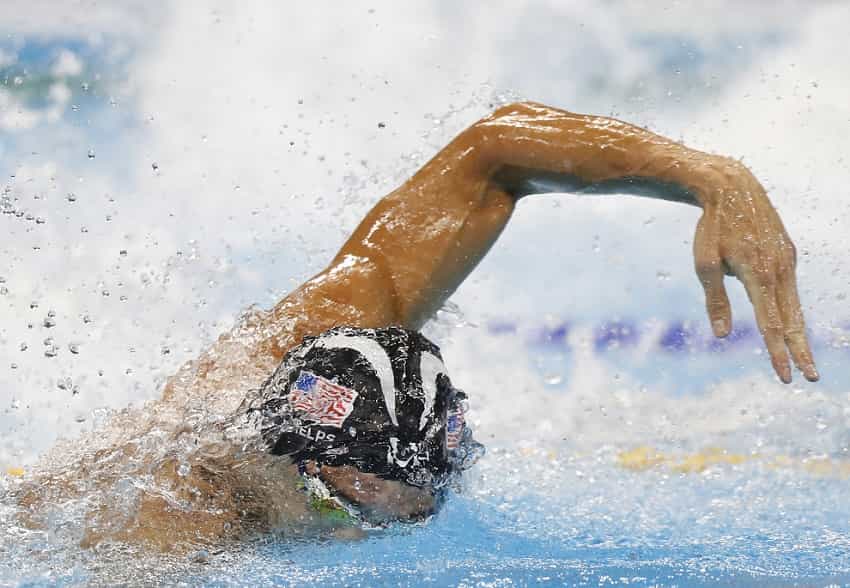
When the hand, led by the middle finger, enters the water, the palm is flat and ready to engage with the catch immediately.
2. Fix the dropped elbow during the recovery.
When swimmers use a “thumb first” hand entry, this is typically because of a dropped elbow during the recovery.
One of the fascinating things about swimming with excellent freestyle stroke is that technique errors compound onto one another.
Bad hand entry is often a symptom of other technique errors. A study performed with a group of NCAA Division I swimmers found that freestyle technique errors were almost always chained to one another.
In the case of improper hand entry, a “thumbs first” hand entry was linked to a dropped elbow during the recovery.
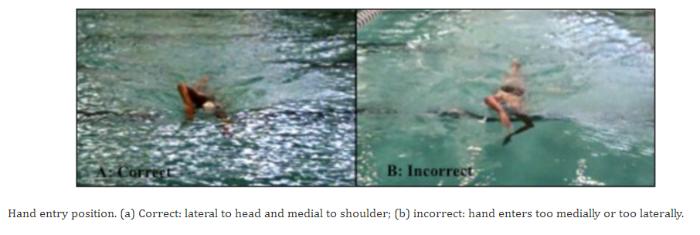
If you are having issues getting a clean hand entry, it can often result from not raising the elbow high enough to allow the hand to “attack” the water.
Technique errors rarely live in isolation, so look upstream of your hand entry to see if other errors in your technique make an efficient hand entry more difficult.
3. Use a “Reach for the Wall” mindset.
The most efficient stroke swimmers take during the course of a length in the pool, whether in swim practice or during a race at a swim meet, is the final stroke.
This stroke is almost always done in the most efficient way possible.
The swimmer extends fully, the hand enters the water at the most efficient and optimal position possible, and the hand is grasping for every last inch of water.
There’s no wasted movement, no side-to-side wiggling, no moving sideways. Charging forward.
Have this mindset when swimming freestyle (or butterfly, breaststroke, and backstroke, for that matter).
Swim for the wall.
“The best [hand] entry anybody on your team makes is when they reach for the wall, as they finish. So we teach ‘reach for the wall.’” – Eddie Reese; a 15-time NCAA championship winner and 6-time Olympic coach for Team USA.
4. Attack with the hand.
One of the lesser-known ways to increase propulsion in the water and improve hand entry is to attack the water with your hand.
Too often, swimmers try to slip perfectly into the water without disturbing it or “slapping” the water.
Which is understandable.
Sloppy swimming is not fast swimming, after all.
But there is too much of a good thing; instead of playing nice with the water, get aggressive and “thrust” the hand forward at the entry.
When we swim at full force and intensity, the body often naturally looks for ways to swim more efficiently.
On top of that, when you attack with the hand into the entry, you generate a coupling motion from the hips and shoulders, increasing velocity and power in the water.
5. Swim with a snorkel to improve head position when breathing.
The swim snorkel is one of the best pieces of swim gear on the pool deck and in your mesh bag.
There are a ton of benefits of swim snorkels, from reducing neck fatigue to encouraging better body position in the water.
But they are also excellent for helping to develop a better hand entry, especially when swimming freestyle.
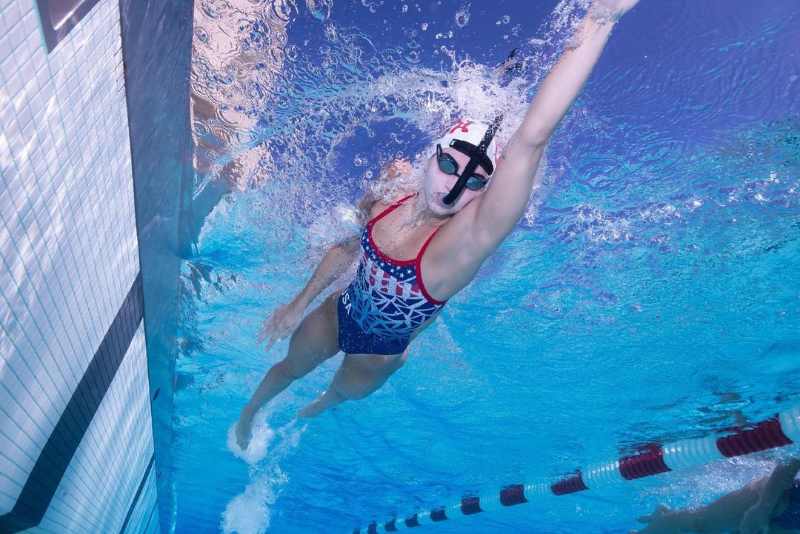
One of the main reasons swimmers struggle with proper hand entry is poor breathing mechanics.
Things like:
- The head swings too much to breathe, swinging the body out of alignment.
- Or the swimmer looks back when breathing, swinging the shoulder under the body, narrowing the angle for attack.
The right swim snorkel can elevate your swimming and improve technique by removing the need to turn the head to breathe; instead, focus 100% on using an excellent hand entry.
Once you get more comfortable with what an efficient hand entry feels like, take off the training wheels (aka the swim snorkel) and transfer that awesome new entry technique to your regular swimming.
6. Improve core strength.
A cross-over hand entry is often the result of poor hip rotation and weak core strength.
A strong core for swimmers not only improves overhead extension and strength, but also allows you to plant your hand into the water where it is most efficient.
A core exercise for swimmers that can help with improved hand entry position is a variation of the standard plank exercise:
- Get into a standard plank position (push-up plank position, not on your forearms)
- Extend one arm straight in front of you so that it is in line with your spine.
- Simultaneously raise the alternate leg.
- Repeat on the other side of the body.
- Do 15-20 reps, for three sets.
Your core will work overtime to maintain balance and stability, very much like how your trunk stiffens to keep a straight bodyline in the water and encourage a stronger hand entry.
7. Use drills to improve hand entry.
There is a large collection of freestyle drills that you can deploy to improve hand entry.
Here are my favorite swim drills for improving this specific part of the swim stroke:
Long dog freestyle
We all learn to dog paddle during our early days in the pool. A variation of this swimming style, long dog drill, is perfect for helping swimmers learn proper hand placement at the top of the stroke.
Instead of recovering the arm above the water, the arms recover under the water.
Altering the angle of hand placement when returning the hand to the top of the pulling motion is a great way to shake swimmers out of bad hand entry habits.
This drill is awesome for teaching your body where the hand should be when it goes into the water.
Increase difficulty as you get more proficient with swim paddles.
Semi-catch-up freestyle
Grab your trusty swim snorkel and do some semi-catch-up drill.
Beginner and intermediate swimmers often screw up catch-up freestyle by bringing the hands together in front of them.
Which encourages a cross-over. Instead, use a semi-catch-up and focus on pushing the hand out in front of you.
The snorkel will reduce any breathing dysfunction so that you can nail proper body position and hand entry.
Alternating single-arm on a kickboard
Another corrective for cross-over freestyle hand entry is to use a kickboard for alternating single arm freestyle.
The key is holding the kickboard at the sides, at shoulder-width.
This is definitely a beginner freestyle drill for giving swimmers the feeling of rotating the arm and using a hand placement in the water that is shoulder-width.
Noon o-clock high
The noon o’clock high drill is an advanced freestyle drill for teaching an aggressive hand entry and improving the power of the coupling motion of the hips and shoulders.
- Strap on a pair fins and swim snorkel.
- Swim slowly with your normal freestyle stroke but pause for a beat when your elbow gets to noon during the arm recovery.
- Take a beat, and then attack the hand entry, using your shoulder and hips to “throw” the hand forward.
This drill helps to reinforce an attack mindset when targeting the hand entry and gives you a sense of how strong the coupling motion can be.
8. Use video feedback to improve hand entry.
The way the freestyle stroke feels in the water isn’t always what is actually happening.
For swimmers who have been crossing the mid-line, switching to an “above the shoulder” hand entry can feel like they are going too wide, leading them to revert to their dysfunctional but “normal feeling” swim technique.
Grab your smartphone or GoPro and do some reps of freestyle, getting video from the front, to see where the hand is actually entering.
You’d be surprised at how often something looks totally different from how it feels when you are swimming.
Wrapping It Up
Mastering proper freestyle hand entry is not just about having your hand enter the water perfectly; it’s about increasing overall efficiency and power in your stroke.
As your hand entry gets better, you will notice that your strokes become longer, you pull more water, and you swim faster.
The next time you hit the pool, try the above tips for sharpening your hand entry, and take your freestyle swimming to new heights of efficiency and speed.
Freestyle Technique Resources
Looking for even more freestyle swimming tips and resources?
We’ve got you covered, from freestyle swimming workouts to how to develop a stronger freestyle kick:
5 Tips for Better Body Position in Swimming (and Why It Matters So Much). Looking to improve your speed and efficiency in the water? Start with proper body position. Here are some ways to improve body position and why it’s so crucial for faster swimming.
6 Freestyle Swim Sets and Workouts. Get your freestyle on with this collection of my favorite freestyle sets. From sprinters to distance swimmers, we’ve got the fastest stroke in the pool covered.
How to Improve Your Freestyle Pull (Plus Sample Swimming Workouts). Ready to level up your freestyle? Here’s how to improve and strengthen your freestyle pull and catch, and a couple of my favorite pull workouts.
How to Develop an Unstoppable Freestyle Kick. The top athletes in the pool are not only fast swimmers, they are fast kickers. Here is your guide to a faster freestyle kick.

